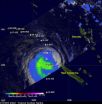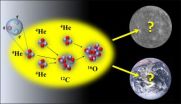(Press-News.org) CHAMPAIGN, Ill. — A little-noticed provision of the Affordable Care Act requires all chain restaurants and retail food establishments with 20 or more locations to list calorie counts on their menus. But according to research co-written by a University of Illinois agricultural economist, numeric calorie labels might not be the most effective way to influence patrons to select "healthier" (often interpreted as lower-calorie) items.
Brenna Ellison, a professor of agricultural and consumer economics, says placing a symbolic label in addition to the numeric calorie information on a menu is a better way to reach more diners, from the least to the most health-conscious.
"Our research found that if only numeric calorie labels are implemented, the effect on calories ordered will be smaller in magnitude, but less health-conscious patrons are still likely to respond to the information by ordering lower-calorie items, which is good," she said. "However, if you go one step further and add a symbol – in our case, a traffic light symbol – to the existing calorie information, that extra step benefits even the most health-conscious individuals."
For the health-conscious, it may provide an extra piece of information that they did not already know.
"The traffic light may function as a normative suggestion as to what is 'better' or 'worse' for diners to eat," Ellison said. "Thus, by reducing the number of calories ordered for diners across all levels of health-consciousness, the combination
calorie-traffic light label seems to be more effective than the numeric calorie label alone."
The research, co-written by Jayson L. Lusk and David Davis, both of Oklahoma State University, was conducted in a full-service restaurant where patrons were randomly assigned one of three different types of menus – some with no information about calories; some with the number of calories listed; and some with a symbol (in this case, a traffic light symbol with red, yellow and green lights indicating specific calorie ranges) in addition to the numeric calorie label.
The results show that the number-only calorie labels had the greatest impact on those who were the least health-conscious.
"That's good news, because this is exactly who the government is trying to reach with this information," Ellison said. "However, labels of any form – so long as they are relatively easy to understand – are likely to have the largest impact on less
health-conscious diners because the information is new to these individuals."
For the highly health-conscious, adding the traffic light symbol to the existing calorie information further reduced the number of calories ordered.
"Calorie counts did provide the most health-conscious with additional information, but it was the symbol that really enhanced the information provided to these consumers," she said. "This is most likely because the symbol offered new information to these diners."
So if the government is looking for a policy that would help the largest possible demographic, adding a symbol to the calorie information might be a more effective way to influence food choices, Ellison says.
"A downside to the Affordable Care Act legislation as currently proposed is that it just provides a number," she said. "If we've learned anything about consumers, it's that people often operate under time constraints and are very convenience-oriented. Not every restaurant diner has time to read – or even wants to read – the number of calories listed for each menu item. Those decisions are often made quickly. For this reason, a symbol might be especially helpful in communicating with the broadest groups of consumers."
In 1980, 30 percent of meals were consumed outside of the home. Now it's about 40 percent, according to the paper. The proportion of food dollars spent outside the home has hovered between 46 and 49 percent since 2000, according to the Economic Research Service.
"Though expenditures outside the home have leveled off in recent years, it's still a substantial proportion of food dollars spent and calories consumed outside of the home," Ellison said. "If the labels work and the effect of the label persists to subsequent restaurant visits, even small reductions in the number of calories consumed could add up in the long run in terms of a few pounds in a year."
But if the labels only result in a one-time calorie reduction, the effect is relatively small. On average, the combination calorie-traffic light label only reduced total calories ordered by about 69 calories, Ellison says.
"An individual could reduce twice as many calories simply by not drinking a soda," she said.
Ellison notes that the research does have an additional takeaway for consumers: Calorie labels were more likely to influence the selection of the main entrée as opposed to supplemental items such as drinks and desserts.
"While both calorie labels reduced entrée calories ordered, both also actually increased extra calories ordered from additional sides, desserts, drinks, etc., compared to the menu with no nutrition information," she said. "So there does seem to be what we call a 'licensing effect,' which could also potentially be a concern. In other words, people might reward themselves for ordering a low-calorie entrée by adding on a dessert, ultimately negating the entrée calorie reduction. Research has shown people don't want to be future-oriented. When you're hungry, you're hungry now. You're not thinking of yourself in 20 years."
Another stumbling block for consumers could be foods that have associated "health halos," Ellison warns.
"Salads are a common example of a food that experiences the 'health halo' effect," she said. "Consumers expect salads to be healthy because they have many vegetables. They think that no matter what else is added to the salad, it should still be healthy. While this logic is often used, unfortunately, it's not sound. In actuality, by adding any type of meat or dressing to a full-portion salad, the salad quickly approaches the threshold for red-light foods."
Ellison says the symbol doesn't necessarily have to be a traffic light.
"It could very well be something else," she said. "The traffic light is being used in the U.K. and Australia in a slightly different form, but since it's being used elsewhere, we wanted to try it here. You could use a star rating system or some other variation, but negative information" – in this case, a red traffic light – "seems to affect people more than positive."
The study also asked respondents which type of label they preferred.
"It turns out that the traffic light was the least preferred even though it was the most effective," she said. "The numeric label, however, was the most well liked, which struck us as odd. It seems as though people want the information, but they don't necessarily want to be told how to apply it. In other words, they want to know how many calories are in foods, but they don't think it's our job to tell them whether those foods are good or bad."
INFORMATION:
The research was published in the International Journal of Behavioral Nutrition and Physical Activity.
Editor's note: To contact Brenna Ellison, call 217-300-0238; email brennae@illinois.edu.
The article, "Looking at the Label and Beyond: The Effects of Calorie Labels, Health Consciousness, and Demographics on Caloric Intake in Restaurants," is available online.
Symbols, such as traffic lights, on menus effective in educating diners
2013-03-14
ELSE PRESS RELEASES FROM THIS DATE:
NASA sees large decrease in Cyclone Sandra's rainfall intensity
2013-03-14
NASA's Tropical Rainfall Measuring Mission satellite, also known as TRMM, flew over Cyclone Sandra twice in one day and noticed a large decrease in rainfall intensity over a nine hour period.
On March 11, 2013, NASA's TRMM satellite twice flew above weakening tropical cyclone Sandra as it was passing to the west of New Caledonia in the southern Pacific Ocean. TRMM's Precipitation Radar (PR) had a very good view of Sandra as it passed directly above the tropical cyclone on March 11 at 1312 UTC (9:12 a.m. EST). TRMM PR measured rainfall at the extreme rate of over 206 mm ...
Dwelling on stressful events can increase inflammation in the body, study finds
2013-03-14
ATHENS, Ohio (March 13, 2013)—Dwelling on negative events can increase levels of inflammation in the body, a new Ohio University study finds.
Researchers discovered that when study participants were asked to ruminate on a stressful incident, their levels of C-reactive protein, a marker of tissue inflammation, rose. The study is the first time to directly measure this effect in the body.
"Much of the past work has looked at this in non-experimental designs. Researchers have asked people to report their tendency to ruminate, and then looked to see if it connected to physiological ...
Scientists discover novel chemical that controls cell behavior
2013-03-14
March 12, 2013 — Albuquerque, NM (UNM Cancer Center) — It's the spread of the original cancer tumor that kills most people. That's why cancer researchers vigorously search for drugs that can prevent metastases, the spread of cancer. The research team co-led by Angela Wandinger-Ness, PhD, and Larry Sklar, PhD, at the University of New Mexico Cancer Center has found a chemical compound that appears to control cell migration and adhesion, two important characteristics of metastatic cancer cells. The team recently published a paper describing how the first-in-class compound ...
Sun spits out 2 CMEs
2013-03-14
The sun recently erupted with two coronal mass ejections (CMEs). One began at 8:36 p.m. EDT on March 12, 2013 and is directed toward three NASA spacecraft, Spitzer, Kepler and Epoxi. There is, however, no particle radiation associated with this event, which is what would normally concern operators of interplanetary spacecraft since the particles can trip computer electronics on board. A second CME began at 6:54 a.m. EDT on March 13, 2013 and its flank may pass by Earth at a speed that does not typically have a significant impact at Earth.
Experimental NASA research models, ...
Vitamin D may lower blood pressure in African-Americans
2013-03-14
Boston – High blood pressure, a risk factor for heart attacks, heart failure and stroke, is 40 percent more common in African-Americans than in other American ethnic groups. In a new study from Brigham and Women's Hospital (BWH), along with the Dana-Farber Cancer Institute and Massachusetts General Hospital, researchers show that vitamin D supplementation may help African-Americans lower their blood pressure. The study publishes online in the March 13, 2013 edition of the American Heart Association journal Hypertension.
"This study may explain and help treat an important ...
US lifespans lags other high-income countries, tied to mortality rates under age 50
2013-03-14
Higher mortality rates among Americans younger than 50 are responsible for much of why life expectancy is lower in the United States than most of the world's most developed nations.
The research, by Jessica Ho, a University of Pennsylvania doctoral candidate in demography and sociology, found that excess mortality among Americans younger than 50 accounted for two-thirds of the gap in life expectancy at birth between American males and their counterparts and two-fifths between females and their counterparts in the comparison countries.
The study, "Mortality Under Age ...
Foundations of carbon-based life leave little room for error
2013-03-14
Life as we know it is based upon the elements of carbon and oxygen. Now a team of physicists, including one from North Carolina State University, is looking at the conditions necessary to the formation of those two elements in the universe. They've found that when it comes to supporting life, the universe leaves very little margin for error.
Both carbon and oxygen are produced when helium burns inside of giant red stars. Carbon-12, an essential element we're all made of, can only form when three alpha particles, or helium-4 nuclei, combine in a very specific way. The ...
UI study of Midwest finds increase in heavy rainfalls over 60 years
2013-03-14
Heavy rains have become more frequent in the upper Midwest over the past 60 years, according to a study from the University of Iowa. The trend appears to hold true even with the current drought plaguing the region, the study's main author says.
The fact that temperatures over the country's midsection are rising, too, may be more than coincidence.The hotter the surface temperature, which has been the trend in the Midwest and the rest of the world, the more water that can be absorbed by the atmosphere. And the more water available for precipitation means a greater chance ...
Video game 'exercise' for an hour a day may enhance certain cognitive skills
2013-03-14
Playing video games for an hour each day can improve subsequent performance on cognitive tasks that use similar mental processes to those involved in the game, according to research published March 13 in the open access journal PLOS ONE by Adam Chie-Ming Oei and Michael Donald Patterson of Nanyang Technological University, Singapore.
Non-gamer participants played five different games on their smartphones for an hour a day, five days of the week for one month. Each participant was assigned one game. Some played games like Bejeweled where participants matched three identical ...
Series of studies first to examine acupuncture's mechanisms of action
2013-03-14
WASHINGTON — While acupuncture is used widely to treat chronic stress, the mechanism of action leading to reported health benefits are not understood. In a series of studies at Georgetown University Medical Center (GUMC), researchers are demonstrating how acupuncture can significantly reduce the stress hormone response in an animal model of chronic stress.
The latest study was published today in the April issue of Journal of Endocrinology.
"Many practitioners of acupuncture have observed that this ancient practice can reduce stress in their patients, but there is a ...



